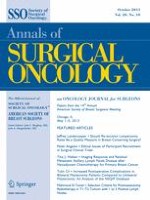Erschienen in:

01.10.2013 | Breast Oncology
Is There a Correlation Between Breast Cancer Molecular Subtype Using Receptors as Surrogates and Mammographic Appearance?
verfasst von:
Brigid K. Killelea, MD, MPH, Anees B. Chagpar, MD, MSc, MPH, MA, Jennifer Bishop, MD, Nina R. Horowitz, MD, Carla Christy, MD, Theodore Tsangaris, MD, Madhavi Raghu, MD, Donald R. Lannin, MD
Erschienen in:
Annals of Surgical Oncology
|
Ausgabe 10/2013
Einloggen, um Zugang zu erhalten
Abstract
Background
The identification of distinct molecular subtypes has changed breast cancer management. The correlation between mammographic appearance and molecular subtype for invasive breast cancer has not been extensively studied.
Methods
A retrospective review of our prospectively collected database was performed to evaluate the mammographic appearance and molecular subtypes of all cases of invasive breast cancers diagnosed between 2003 and 2010.
Results
There were 985 cases of invasive breast cancer with complete data on receptor status and mammographic appearance. The most common mammographic finding was a mass (61 %), and the most common molecular subtype was ER/PR positive, HER2 negative (71 %). On univariate analysis, race, stage, and histology were all significantly associated with molecular subtype. On multivariate analysis, the luminal molecular type was associated with architectural distortion [odds ratio (OR) 4.3, 95 % CI 1.3–14.1]; HER2 positive cancers, either with or without ER/PR expression, were more likely to be associated with mammographic calcifications (OR 2.8 and 3.1, respectively; 95 % CI 1.7–4.8 and 1.7–5.5); and triple negative cancers were most likely to be associated with a mammographic mass (OR 2.5; 95 % CI 1.4–4.4).
Conclusions
We observed several characteristic associations between molecular subtype and mammographic appearance. Improved understanding of these associations may help guide clinical decision making and provide information about underlying tumor biology.